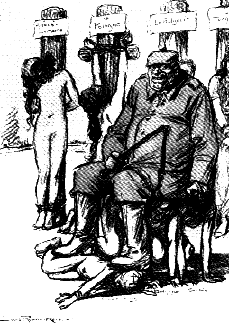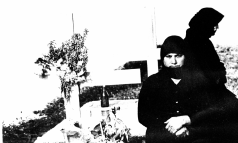flatter than the plains of Kansas, flatter than the lowlands of Hungary. On such terrain a ten-foot rise is a military prize worth fighting for. This was once a land of grassy, tree-filled, primeval swamps. Even after three years of war its scrubby desolation still gave the impression of a forest clearing.The plain is part of the one that runs from the Pyrenees to Russia, the only gateway into France which bypasses formidable mountains and plateaus.
Flanders at any time is a monotonous countryside. There are no landmarks except houses and the gentlest of ridges. Single hills are rare. One of the few is Mount Kemmel, the loftiest peak in all the land, three hundred fifty feet high. Rivers and canals wind their way at random, merge into one another, separate, flow toward the ocean, then away from it; for the slope of the ground is too slight to create a normal pattern.
During the rainy seasons the rivers cannot discharge their waters because of the faintness of the gradient. Most of them flood once or more yearly. When they do, they spread their waters far and wide. Many of them have been straightened and canalized. Dikes and drainage watercourses are everywhere and marshes have been generally reclaimed, but still the waters overflow to some extent yearly, especially in the late summer and fall. And in the words of Sir Douglas Haig's Chief of Intelligence,
Careful investigation of the records of more than 80 years showed that in Flanders the weather broke early each August with the regularity of the Indian monsoon.
The one major exception to the flatness is the famous ridge, an arc of feeble hills and highlands running from some miles north of Passchendaele southward to Messines and then west toward Hazebrouck. Its average elevation is about one hundred fifty feet. Yet the German holders of these modest heights enjoyed a great military advantage not only in observation but in the placement of guns and defensive fortifications.
Since earliest times military offensives have failed in this mild-seeming land because of a physical obstacle not apparent to the glance; for in Flanders the ground is almost pure fine-grained clay, sometimes with a crust of sand on top or a thin coating of loam. In certain places there is no topsoil at all; these clay fields, called clyttes, exist at their worst north of Ypres in the vicinity of the Houthulst Forest. Because of the impervious clay, the rain cannot escape and tends to stagnate over large areas. Unable to soak through, it forms swamps and ponds, and sluggishly spreads toward one of the already swollen rivers or canals. The ground remains perpetually saturated. Water is reached at an average depth of eighteen inches and only the shallowest of puddly trenches can be dug by the troops, reinforced by sandbag parapets. When the topsoil dries during fair weather, it cracks open. The next rain floods the fissures. Then the clay blocks slide upon themselves, causing little landslides.
The problem of terrain has bedeviled military commanders in Flanders throughout history. In the early 1700s Marlborough told how "our armies swore terribly in Flanders." By a curious transposition of numerals, in 1197 Philip Augustus was trapped with his army in the morass southwest of Ypres, and similar frustrations occurred during the days of the Roman conquest. For clay plus water equals mud --- not the chalky mud of the Somme battlefield to the south, but gluey, intolerable mud. The British War Office Archives are full of reports in this vein:
"Part of company bogged in communications trench south of St. Eloi; two men smothered."
"Three men suffocated in mud near Voormezeele."
"Men had to lie flat and distribute their weight evenly in order to prevent sinking into the mire."
"The trenches are very wet, and the water is up to the men's knees in most places."
"Trenches full of liquid mud 2 to 3 feet deep."
"Men in pitiable condition coming out of trenches; wet through, caked with stinking mud from head to foot."
When one officer was instructed to consolidate his advance position, he wrote back, "It is impossible to consolidate porridge."
"Trenches full of liquid mud. Smelt horribly. Full of dead Frenchmen too bad to touch. Men quite nauseated."
 Everywhere by 1917 the water was contaminated, and the deIivery of fresh water was a major operation. The filthy surface wash was locked in by the clay. Rivers and canals were polluted by refuse from the flooded land, and even the artesian wells had become poisoned. The decay and refuse of millions of men, alive and dead, sank into the soil and were carried by the blackened waters throughout the inland plain. These conditions were most severe on the maritime strip west of the Yser, where the land is lower than sea level at high tide. If not for the drains and dikes, some sections would be ten feet under water, and, in fact, this had become the precise situation after the Belgians inundated the area in 1914...
Everywhere by 1917 the water was contaminated, and the deIivery of fresh water was a major operation. The filthy surface wash was locked in by the clay. Rivers and canals were polluted by refuse from the flooded land, and even the artesian wells had become poisoned. The decay and refuse of millions of men, alive and dead, sank into the soil and were carried by the blackened waters throughout the inland plain. These conditions were most severe on the maritime strip west of the Yser, where the land is lower than sea level at high tide. If not for the drains and dikes, some sections would be ten feet under water, and, in fact, this had become the precise situation after the Belgians inundated the area in 1914...
In this landscape nothing existed but a measureless bog of military rubble, shattered houses, and tree stumps. It was pitted with shell craters containing fetid water. Overhead hung low clouds of smoke and fog. The very ground was soured by poison gas. Not one building was intact. Only mounds overrun with scrub grass, interspersed with old brick and fragments of wood, showed where many houses had formerly stood.
In the center of this incarnation of ruin lay the dead city of Ypres --- "Wipers" it was always called --- obliterated, crushed like a pile of discarded baby's toys left out in the rain. Yet this mournful corpse, like a skeleton in a nightmare, seemed to live; for though it no longer possessed a normal spirit it was a turmoil of military activity. The traffic on the roads and in the shattered market place was enormous and without end, though the town was shelled day and night, and since 1914 had been bombed more than any other target on the Western Front, Major General John Monash, commander of the 3rd Australian Division, in a war letter to his wife described the scene thus:
. . . streams of men, vehicles, motor lorries, horses, mules, and motors of every description, moving ponderously forward, at a snail's pace, in either direction hour after hour, all day and all night, day after day, week after week, in a never halting, never ending stream...ploughing its way slowly and painfully through the mud...a reek of petrol and smoke everywhere.
Here comes a body of fighting troops, tin-hatted and fully
equipped, marching in file into the battle area, to carry out a relief of some front-line division. There follows a string of perhaps one hundred motor lorries, all fully loaded with supplies; a limousine motor-car with some division staff-officer; a string of regimental horse- and mule-drawn vehicles going up to a forward transport park; some motor-ambulance wagons...a long string of remount horses, marching in twos...a great 12-inch howitzer, dragged by two steam-traction engines, returning from the workshops after repair of injuries received; more infantry, thousands of them; more ambulances, more motor lorries; a long stream of Chinese coolies, smart and of magnificent stature...dispatch riders on motor bikes threading their way skilfully between the gaps; a battery of artillery all fully horsed and clattering and jingling; motor lorries again, heavily loaded with artillery ammunition...wagons bringing forward broken stone and road-making materials...a mounted police detachment...an "Archie" (anti-aircraft gun), steam-motor drawn, going to take up a more forward position...a Royal Flying Corps car carrying parts of aeroplanes to forward hangars; more ambulances; and so on and on and on in a never-ending stream.
©1958, Viking Press
 Everywhere by 1917 the water was contaminated, and the deIivery of fresh water was a major operation. The filthy surface wash was locked in by the clay. Rivers and canals were polluted by refuse from the flooded land, and even the artesian wells had become poisoned. The decay and refuse of millions of men, alive and dead, sank into the soil and were carried by the blackened waters throughout the inland plain. These conditions were most severe on the maritime strip west of the Yser, where the land is lower than sea level at high tide. If not for the drains and dikes, some sections would be ten feet under water, and, in fact, this had become the precise situation after the Belgians inundated the area in 1914...
Everywhere by 1917 the water was contaminated, and the deIivery of fresh water was a major operation. The filthy surface wash was locked in by the clay. Rivers and canals were polluted by refuse from the flooded land, and even the artesian wells had become poisoned. The decay and refuse of millions of men, alive and dead, sank into the soil and were carried by the blackened waters throughout the inland plain. These conditions were most severe on the maritime strip west of the Yser, where the land is lower than sea level at high tide. If not for the drains and dikes, some sections would be ten feet under water, and, in fact, this had become the precise situation after the Belgians inundated the area in 1914... The fields of Flanders are mostly flat, flatter than the plains of Kansas, flatter than the lowlands of Hungary. On such terrain a ten-foot rise is a military prize worth fighting for. This was once a land of grassy, tree-filled, primeval swamps. Even after three years of war its scrubby desolation still gave the impression of a forest clearing.The plain is part of the one that runs from the Pyrenees to Russia, the only gateway into France which bypasses formidable mountains and plateaus.
The fields of Flanders are mostly flat, flatter than the plains of Kansas, flatter than the lowlands of Hungary. On such terrain a ten-foot rise is a military prize worth fighting for. This was once a land of grassy, tree-filled, primeval swamps. Even after three years of war its scrubby desolation still gave the impression of a forest clearing.The plain is part of the one that runs from the Pyrenees to Russia, the only gateway into France which bypasses formidable mountains and plateaus.